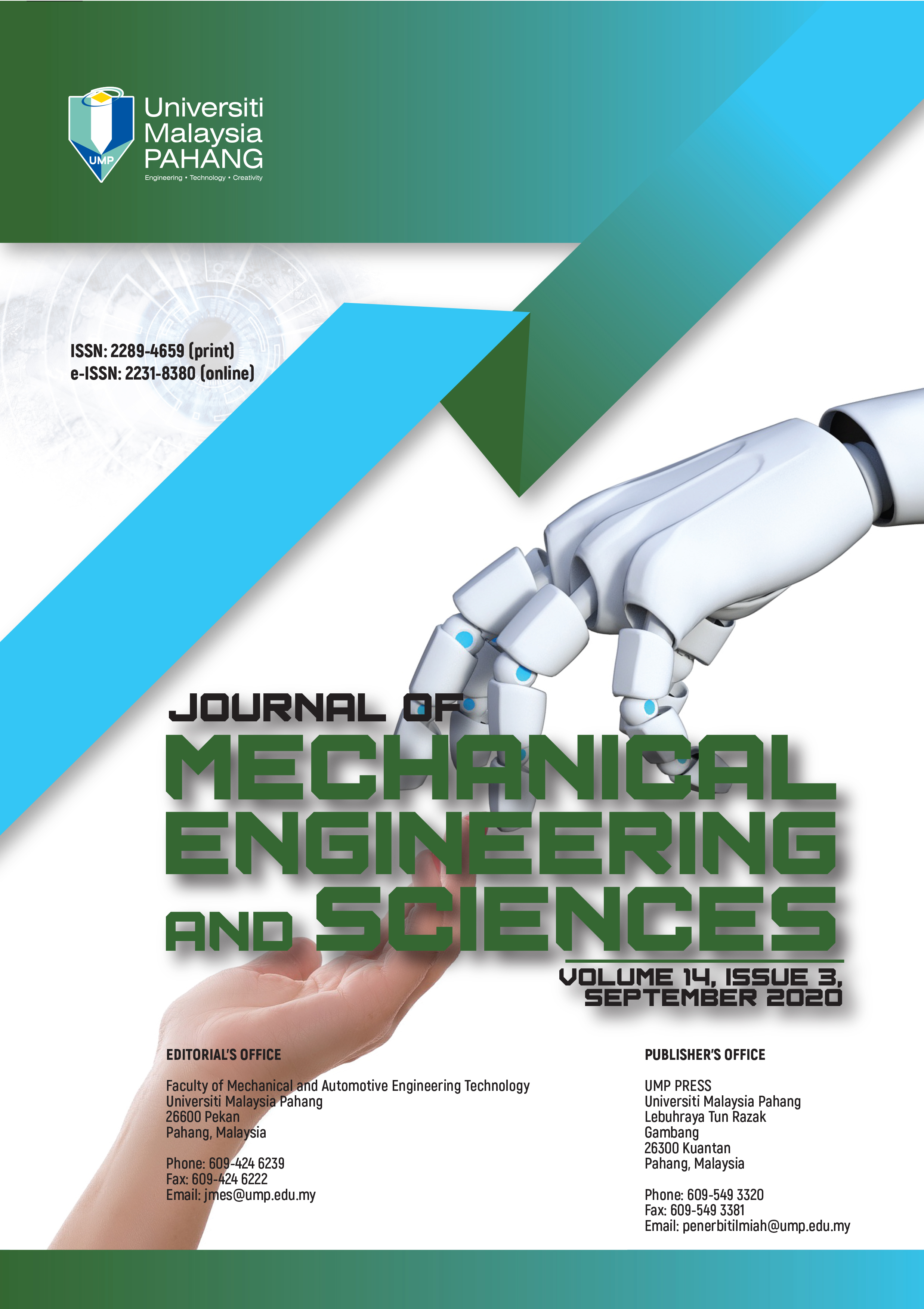Effect of dome size on flow dynamics in saccular aneurysms – A numerical study
DOI:
https://doi.org/10.15282/jmes.14.3.2020.19.0564Keywords:
Computational Fluid Dynamics, Aneurysm, Wall shear stress, Velocity Vectors, Dome SizeAbstract
Image-based Computational Fluid Dynamic (CFD) simulations of anatomical models of human arteries are gaining clinical relevance in present days. In this study, CFD is used to study flow behaviour and hemodynamic parameters in aneurysms, with a focus on the effect of geometric variations in the aneurysm models on the flow dynamics. A computational phantom was created using a 3D modelling software to mimic a spherical aneurysm. Hemodynamic parameters were obtained and compared with the available literature to validate. Further, flow dynamics is studied by varying the dome size of the aneurysm from 3.75 mm to 6.25 mm with an increment of 0.625 mm keeping the neck size constant. The aneurysm is assumed to be located at a bend in the arterial system. Computational analysis of the flow field is performed by using Navier – Stokes equation for laminar flow of incompressible, Newtonian fluid. Parameters such as velocity, pressure, wall shear stress (WSS), vortex structure are studied. It was observed that the location of the flow separation and WSS vary significantly with the geometry of the aneurysm. The reduction of WSS inside the aneurysm is higher at the larger dome sizes for constant neck size.
References
B. Weir, “Unruptured intracranial aneurysms: a review,” J. Neurosurg., vol. 96, no. 1, pp. 3–42, 2002.
G. Mulder, A. C. B. Bogaerds, P. Rongen, and F. N. van de Vosse, “On automated analysis of flow patterns in cerebral aneurysms based on vortex identification,” J. Eng. Math., vol. 64, no. 4, p. 391, 2009.
Y. Hoi et al., “Effects of arterial geometry on aneurysm growth: three-dimensional computational fluid dynamics study,” J. Neurosurg., vol. 101, no. 4, pp. 676–681, 2004.
K. Sato, Y. Imai, T. Ishikawa, N. Matsuki, and T. Yamaguchi, “The importance of parent artery geometry in intra-aneurysmal hemodynamics,” Med. Eng. Phys., vol. 30, no. 6, pp. 774–782, 2008.
Y. Imai, K. Sato, T. Ishikawa, and T. Yamaguchi, “Inflow into saccular cerebral aneurysms at arterial bends,” Ann. Biomed. Eng., vol. 36, no. 9, p. 1489, 2008.
J. L. Thenier-Villa et al., “Hemodynamic changes in the treatment of multiple intracranial aneurysms: A computational fluid dynamics study,” World Neurosurg., vol. 118, pp. e631--e638, 2018.
T. Sano, F. Ishida, M. Tsuji, K. Furukawa, S. Shimosaka, and H. Suzuki, “Hemodynamic differences between ruptured and unruptured cerebral aneurysms simultaneously existing in the same location: 2 case reports and proposal of a novel parameter oscillatory velocity index,” World Neurosurg., vol. 98, pp. 868--e5, 2017.
M. Meuschke, S. Voß, B. Preim, and K. Lawonn, “Exploration of blood flow patterns in cerebral aneurysms during the cardiac cycle,” Comput. Graph., vol. 72, pp. 12–25, 2018.
L. Xu, B. Zhao, X. Liu, and F. Liang, “Computational methods applied to analyze the hemodynamic effects of flow-diverter devices in the treatment of cerebral aneurysms: Current status and future directions,” Med. Nov. Technol. Devices, vol. 3, p. 100018, 2019.
G. Janiga, L. Daróczy, P. Berg, D. Thévenin, M. Skalej, and O. Beuing, “An automatic CFD-based flow diverter optimization principle for patient-specific intracranial aneurysms,” J. Biomech., vol. 48, no. 14, pp. 3846–3852, 2015.
P. Goswami, D. K. Mandal, N. K. Manna, and S. Chakrabarti, “Numerical investigations of various aspects of plaque deposition through constricted artery,” J. Mech. Eng. Sci., vol. 13, no. 3, pp. 5306–5322, 2019.
T. Hassan, Y. M. Ahmed, and A. A. Hassan, “The adverse effects of flow-diverter stent-like devices on the flow pattern of saccular intracranial aneurysm models: computational fluid dynamics study,” Acta Neurochir. (Wien)., vol. 153, no. 8, pp. 1633–1640, 2011.
Y. H. Kim, X. Xu, and J. S. Lee, “The effect of stent porosity and strut shape on saccular aneurysm and its numerical analysis with lattice Boltzmann method,” Ann. Biomed. Eng., vol. 38, no. 7, pp. 2274–2292, 2010.
M. H. Babiker, L. F. Gonzalez, F. Albuquerque, D. Collins, A. Elvikis, and D. H. Frakes, “Quantitative effects of coil packing density on cerebral aneurysm fluid dynamics: an in vitro steady flow study,” Ann. Biomed. Eng., vol. 38, no. 7, pp. 2293–2301, 2010.
C. F. Gonzalez, Y. I. Cho, H. V Ortega, and J. Moret, “Intracranial aneurysms: flow analysis of their origin and progression.,” Am. J. Neuroradiol., vol. 13, no. 1, pp. 181–188, 1992.
N. F. Kassell and J. C. Torner, “Size of intracranial aneurysms,” Neurosurgery, vol. 12, no. 3, pp. 291–297, 1983.
L. Parlea, R. Fahrig, D. W. Holdsworth, and S. P. Lownie, “An analysis of the geometry of saccular intracranial aneurysms,” Am. J. Neuroradiol., vol. 20, no. 6, pp. 1079–1089, 1999.
H. Ujiie, Y. Tamano, K. Sasaki, and T. Hori, “Is the aspect ratio a reliable index for predicting the rupture of a saccular aneurysm?,” Neurosurgery, vol. 48, no. 3, pp. 495–503, 2001.
Y. Hoi, S. H. Woodward, M. Kim, D. B. Taulbee, and H. Meng, “Validation of CFD simulations of cerebral aneurysms with implication of geometric variations,” J. Biomech. Eng., vol. 128, no. 6, pp. 844–851, 2006.
K. Sudo, M. Sumida, and R. Yamane, “Secondary motion of fully developed oscillatory flow in a curved pipe,” J. Fluid Mech., vol. 237, pp. 189–208, 1992.
A. J. Geers, I. Larrabide, H. G. Morales, and A. F. Frangi, “Approximating hemodynamics of cerebral aneurysms with steady flow simulations,” J. Biomech., vol. 47, no. 1, pp. 178–185, 2014.
J. P. Ku, C. J. Elkins, and C. A. Taylor, “Comparison of CFD and MRI flow and velocities in an in vitro large artery bypass graft model,” Ann. Biomed. Eng., vol. 33, no. 3, pp. 257–269, 2005.
A. Sherikar and P. J. Disimile, “RANS study of very high Reynolds-number plane turbulent Couette flow,” J. Mech. Eng. Sci., vol. 14, no. 2, pp. 6663–6678, 2020.
N. Kumar, A. Khader, R. Pai, P. Kyriacou, S. Khan, and P. Koteshwara, “Computational fluid dynamic study on effect of Carreau-Yasuda and Newtonian blood viscosity models on hemodynamic parameters,” J. Comput. Methods Sci. Eng., vol. 19, no. 2, pp. 465–477, May 2019.
V. Mendez, M. Di Giuseppe, and S. Pasta, “Comparison of hemodynamic and structural indices of ascending thoracic aortic aneurysm as predicted by 2-way FSI, CFD rigid wall simulation and patient-specific displacement-based FEA,” Comput. Biol. Med., vol. 100, pp. 221–229, 2018.
E. A. Kosasih, R. F. Karim, J. Julian, and others, “Drag reduction by combination of flow control using inlet disturbance body and plasma actuator on cylinder model,” J. Mech. Eng. Sci., vol. 13, no. 1, pp. 4503–4511, 2019.
N. Kumar, S. M. A. Khader, R. Pai, S. H. Khan, and P. A. Kyriacou, “Fluid structure interaction study of stenosed carotid artery considering the effects of blood pressure,” Int. J. Eng. Sci., vol. 154, p. 103341, 2020.
Y. Zhang et al., “Hemodynamic effects of stenting on wide-necked intracranial aneurysms,” Chin. Med. J. (Engl)., vol. 123, no. 15, pp. 1999–2003, 2010.
H. Ujiie et al., “Effects of size and shape (aspect ratio) on the hemodynamics of saccular aneurysms: a possible index for surgical treatment of intracranial aneurysms,” Neurosurgery, vol. 45, no. 1, pp. 119–130, 1999.
A. M. Malek, S. L. Alper, and S. Izumo, “Hemodynamic shear stress and its role in atherosclerosis,” Jama, vol. 282, no. 21, pp. 2035–2042, 1999.
J. R. Cebral, M. Sheridan, and C. M. Putman, “Hemodynamics and bleb formation in intracranial aneurysms,” Am. J. Neuroradiol., vol. 31, no. 2, pp. 304–310, 2010.
Downloads
Published
Issue
Section
License
Copyright (c) 2020 The Author(s)

This work is licensed under a Creative Commons Attribution-NonCommercial 4.0 International License.






